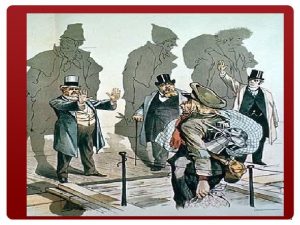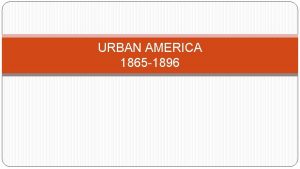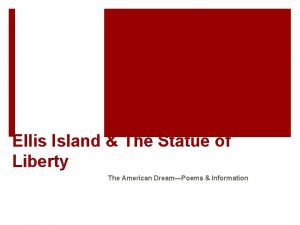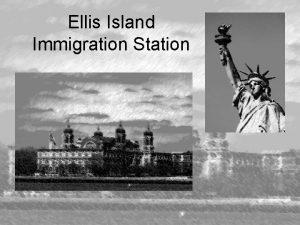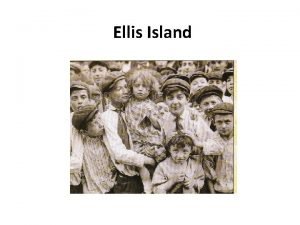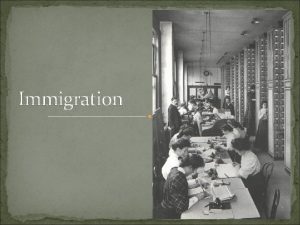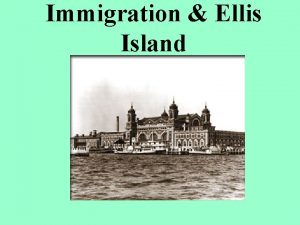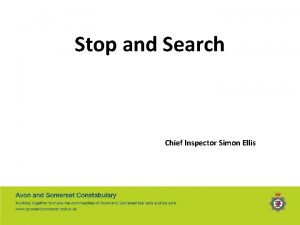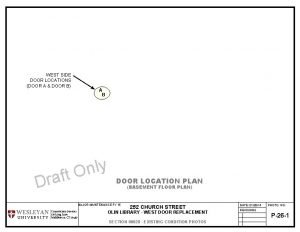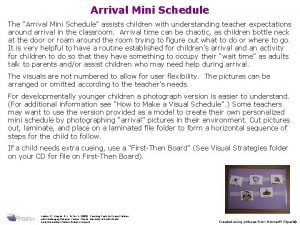Ellis Island The Golden Door Stop 1 Arrival



































- Slides: 35

Ellis Island The Golden Door

Stop 1: Arrival • New arrivals were taken by ferry to the main building at Ellis Island. Opened in 1892, the first immigrant to arrive was a 15 -year-old girl from Ireland named Annie Moore to join her parents in New York City.

Not everyone arriving in New York had to go to Ellis Island. Immigrants in first- and second-class were processed aboard their ships soon after docking on the mainland. Onboard exams were shorter than those on the island, since inspectors were more accepting of anyone who could afford the higher fare.

Most of the immigrants who passed through Ellis Island were poor. They crammed by the thousands aboard steamships that took weeks to cross the Atlantic Ocean. Most spent all the money they had just to ride in third class — called steerage. Photo: Library of Congress

The single busiest day in Ellis Island history came on April 17, 1907, when 11, 747 immigrants were processed for admission into the United States. Some of them had been waiting days just to get on to the island. Photo: National Park Service/US Dept. of Interior

After 1907, children under 16 had to be accompanied by their parents or else they would be sent back. Photo: National Park Service/US Dept. of Interior

On September 27, 1907, so many English and Irish young women arrived at Ellis Island aboard the steamship Baltic that the New York papers referred to them as the "1, 000 Marriageable Girls. " Many of them hoped to find work as domestic servants or shopkeepers. Photo: CORBIS

Stop 2: Baggage Claim • Immigrants entered the main building through its ground floor baggage room. They left their trunks, suitcases and baskets here until they were finished. Immigrants with only a few belongings carried their things as they climbed the stairs to the Great Hall for medical and legal examinations.

Children were a common sight at Ellis Island. During its 62 years in operation, 355 babies were actually born on the island! Photo: Bettmann/CORBIS

More Italians entered through Ellis Island than any other group. Between 1892– 1954, four million immigrants arrived from Italy. Photo: Library of Congress

In addition to Europeans, immigrants of African descent passed through Ellis Island. Coming mainly from the Caribbean and Cape Verde, 100, 000 of them entered between 1900 and 1920 alone. Photo: CORBIS

Between 1921– 1930, over 100, 000 families from Czechoslovakia came through Ellis Island, up from just 3, 500 a decade before. Photo: Bettmann/CORBIS

Stop 3: Stairway to the Great Hall • The first test the immigrants had to pass became known as the "six second medical exam. " As the immigrants climbed the stairs to the Great Hall, doctors stood at the top and watched. They were looking for anyone having difficulty coming up the steps. If a medical problem or disability was suspected, one of seventeen different chalk marks was put on the person's clothing. They were then sent for a full physical examination. If they weren't marked, they went on to wait in the Great Hall.

Medical Chart • X – Suspected Mental Defect • Circled X- Definite Signs of Mental Defects • B – Back • C- Conjunctivitis • CT – Trachoma • E- Eyes • F- Face • Ft- Feet • • • G- Goiter H- Heart K- Hernia N- Neck L- Lameness P- Physical & Lungs PG- Pregnancy SC- Scalp S- Senility SI- Special Inquiry

Stop 4: Medical Exam • By 1917, complete medical exams were required for every immigrant. The main purpose of these exams was to find persons with contagious diseases or conditions that would make them unable to work. If their problem was curable, immigrants were sent to the island's hospital. If it was not, the steamship company that brought them would have to pay to send them back. Photo: Library of Congress

The 15 medical buildings of Ellis Island stood across the ferry slip from the main building, and included hospital wards, operating rooms, an Xray plant, and even a morgue. Photo: Library of Congress

The dreaded "eye man" was the name immigrants gave to the doctor who inspected them for trachoma, a highly contagious disease that caused blindness. Using a hooked tool or his fingers, he would pinch a person's eyelid, turn it over, and look for any signs of the disease. Photo: National Park Service/US Dept. of Interior

Any immigrant chalk-marked with an "X" underwent mental exams that tested their intelligence. Often these exams were wooden puzzles of the human face. If a person didn't pass, they would be sent back. Photo: National Park Service/US Dept. of Interior

Parents were allowed to carry their small children through Ellis Island. But during the medical exam, all children two years or older were required to show doctors that they could walk on their own. Photo: Bettmann/CORBIS

Stop 5: The Great Hall • The Great Hall was the large waiting room of Ellis Island. Immigrants waited here for their interviews with legal inspectors after finishing their medical exams. At best, the entire process through Ellis Island took three to five hours. But sometimes problems came up, like family members waiting for a relative to be treated in the hospital ward. Some families stayed for days on Ellis Island, others for weeks, and still others for months. Photo: Library of Congress

The dining hall for detainees could seat up to 1, 200. The menu featured beef stew or baked beans, and extra crackers and milk were provided at each meal for women and children. Photo: National Park Service/US Dept. of Interior

Many reforms to improve Ellis Island began under President Theodore Roosevelt. One simple improvement came in 1903 — benches were added for immigrants to sit on while waiting in the Great Hall. Photo: Underwood & Underwood/CORBIS

After World War I, beds replaced bunks in the over crowded dormitories. But men and women still slept in separate dormitories until individual family bedrooms were added in the late 1920 s. Photo: Bettmann/CORBIS

Over the years, private charitable societies provided classes for children of detainees on Ellis Island. Volunteers also operated a library and offered cultural events like music performances to familiarize immigrants with their new country. Photo: Underwood & Underwood/CORBIS

Stop 6: Legal Inspection • After passing the medical exams, immigrants had to prove they could legally come into America. They had to prove their country of origin and where they expected to live and work once they entered the country. Inspectors rejected any immigrant with a criminal record or those suspected of being indentured servants. By 1921, immigrants had to pass a literacy test and show a passport and visa. Photo: Library of Congress





Stop 7: Money Exchange • In the money exchange area immigrants exchanged the money of their homeland for dollars, and purchased any train tickets they needed. Laws passed in 1909 required each immigrant to have at least 20 dollars before they were allowed to enter America. Photo: National Park Service/US Dept. of Interior

Immigrants continuing by train to points beyond New York could buy food for their journey at a concession stand. A box lunch of sandwiches, fruit, and pie sold for 50 cents — that's well over ten dollars by today's standards. Photo: National Park Service/US Dept. of Interior

Often immigrants arrived to the United States dressed in the exotic clothing of their homeland. This made them easy targets for anyone looking to take advantage of a recent arrival. To aid their transition, charitable societies offered immigrants free American-style clothing before they left Ellis Island. Photo: CORBIS

Women traveling alone were not allowed to leave Ellis Island until immigration officers felt they were in safe hands. In some cases, concerned officers took it upon themselves to escort a woman to a connecting train or proper lodgings in New York City. Photo: National Park Service/US Dept. of Interior

Stop 8: The Journey’s End • Just beyond the money exchange was the exit from Ellis Island. Staff members referred to this spot as the kissing post because of all the emotional reunions that were witnessed there. Two thirds of the new Americans then boarded a ferry to New Jersey, where the next leg of their American journey would begin. The remaining third took the ferryboat to Manhattan to begin their new life in New York City, only one mile away. Photo: Library of Congress http: //www. youtube. com/watch? v=8 X 4 Cyp. Ta. OQs

Tour Ellis Island • https: //www. ellisisland. org/ • 1. Peruse the website, taking notes as you go – interesting facts, important dates, etc. • 2. Pick a relative or friend (last name) and see when and if they emigrated through Ellis Island. Look at the copies of the documents.
 The golden door ellis island
The golden door ellis island Ellis island and angel island venn diagram
Ellis island and angel island venn diagram Angel island vs ellis island
Angel island vs ellis island Folio bucket in front office
Folio bucket in front office Immigrants passing through ellis island
Immigrants passing through ellis island Ellis island joseph bruchac
Ellis island joseph bruchac Scholastic interactive tour of ellis island
Scholastic interactive tour of ellis island Isle of tears ellis island
Isle of tears ellis island Ellis island inspection card
Ellis island inspection card Michelle ellis
Michelle ellis Ellis island inspections
Ellis island inspections Ellis island matkustajaluettelot
Ellis island matkustajaluettelot Direct energy door to door
Direct energy door to door Door to door luggage service switzerland
Door to door luggage service switzerland One stop teacher stop
One stop teacher stop De lin institute of technology
De lin institute of technology Modified fibonacci sequence
Modified fibonacci sequence The golden ratio
The golden ratio What is a island?
What is a island? Island of the blue dolphins map
Island of the blue dolphins map Thiếu nhi thế giới liên hoan
Thiếu nhi thế giới liên hoan điện thế nghỉ
điện thế nghỉ Một số thể thơ truyền thống
Một số thể thơ truyền thống Trời xanh đây là của chúng ta thể thơ
Trời xanh đây là của chúng ta thể thơ Thế nào là hệ số cao nhất
Thế nào là hệ số cao nhất Sơ đồ cơ thể người
Sơ đồ cơ thể người Ng-html
Ng-html Bảng số nguyên tố lớn hơn 1000
Bảng số nguyên tố lớn hơn 1000 Tia chieu sa te
Tia chieu sa te đặc điểm cơ thể của người tối cổ
đặc điểm cơ thể của người tối cổ Các châu lục và đại dương trên thế giới
Các châu lục và đại dương trên thế giới Chụp tư thế worms-breton
Chụp tư thế worms-breton ưu thế lai là gì
ưu thế lai là gì Tư thế ngồi viết
Tư thế ngồi viết Cái miệng bé xinh thế chỉ nói điều hay thôi
Cái miệng bé xinh thế chỉ nói điều hay thôi Các châu lục và đại dương trên thế giới
Các châu lục và đại dương trên thế giới


